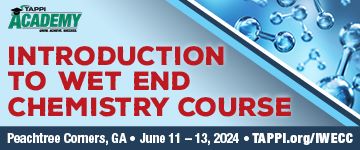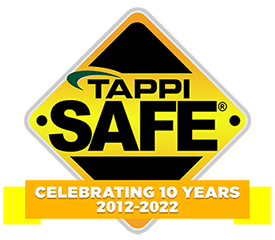 Search
Search
Use the search bar or filters below to find any TAPPI product or publication.
Filters
Content Type
Publications
Level of Knowledge
Collections
Magazine articles

An overview of the south african pulp and paper industry, TAPPI JOURNAL, April 1999, Vol. 82(4)
An overview of the south african pulp and paper industry, TAPPI JOURNAL, April 1999, Vol. 82(4)
Magazine articles

Retention aids for highspeed paper machines, TAPPI JOURNAL, April 1999, Vol. 82(4)
Retention aids for highspeed paper machines, TAPPI JOURNAL, April 1999, Vol. 82(4)
Magazine articles

Good manufacturing practices in recycled paper and paperboard production for use in food packaging, TAPPI JOURNAL, August 1999, Vol. 82(8)
Good manufacturing practices in recycled paper and paperboard production for use in food packaging, TAPPI JOURNAL, August 1999, Vol. 82(8)
Journal articles

Magazine articles

Water chemistry challenges in pulping and papermaking • fundamentals and practical insights: Part 2: Conductivity, charge, and hardness, TAPPI Journal June 2023
ABSTRACT: Although water is essential to the papermaking process, papermakers often overlook its importance and focus on fibers, fillers, and chemical additives. A better understanding of water properties and chemical interactions associated with water at the wet end leads to a sound foundation for high-quality paper production and smooth operation. Water is an excellent solvent for ionic substances, both organic and inorganic. These substances contribute to system conductivity, charge, and hardness and significantly impact the papermaking process. Part 1 of this paper, published in TAPPI J. 21(6): 313(2022), discussed fundamental water properties, water chemistry, and the impact of pH on pulping and papermaking operations. In this paper, we review definitions, sources, and the typical symptoms of the effect of conductivity, charge, and hardness on the productivity of the papermaking process. Sources of conductivity, charge, and hardness impacting these factors, measurement methods, and available correction strategies for their control are also discussed.
Journal articles

Magazine articles

Improvements in oil and grease resistance (OGR) test methodology for waterborne barrier coatings, TAPPI Journal November 2022
ABSTRACT: Paper-based food packaging is becoming more popular due to consumer demands for sustainable packaging options. Waterborne paper coatings that provide performance properties (i.e., resistance to oil and grease) not inherent to paper and board substrates offer improved sustainability profiles over earlier paper treatment options, including fluorocarbon treatment and coating with extruded plastics. The continued development of new paper coating technologies requires re-evaluation of current test methods and development of new methods to ensure lab evaluations can serve as accurate predictors of real-world performance. This paper provides an overview of commonly used oil and grease resistance (OGR) test methods within the paper coatings industry, and then describes improvements and developments made to two key methods: the 3M Kit test and an internally developed oil breakthrough test. The combined use of these adapted methods provides a more efficient testing workflow and a more complete understanding of the OGR performance of barrier coatings.
Journal articles

Magazine articles

Editorial: The road to sustainable packaging: New research on aqueous barrier coating, TAPPI Journal November 2022
ABSTRACT: This TAPPI Journal Special Coating Issue looks at hot topic research being done in coatings for paper and paperboard. We can feel the “earth shifting” in paper and paper-board packaging due to the strong call by consumers and brand owners for more sustainable and environmentally friendly options. This is the first TAPPI Journal Special Coating Issue to highlight efforts within the paper coating community to produce more sustainable packaging.
Journal articles

Magazine articles

Alkyl ketene dimer (AKD) sized paper reversion due to oxidative photodegradation, TAPPI Journal January 2024
ABSTRACT: Alkyl ketene dimer (AKD) is a sizing agent used in papermaking to increase the resistance of paper-board towards water penetration. The acquired hydrophobic property of the paper can be reversed due to the instability of the sizing agent. It is broadly known that AKD size reversion is due to migration, poor orientation, masking, or hydrolysis of the sizing agent. Unfortunately, the environmental parameters that cause this chemical instability are not well understood. Thus, the conditions that initiate or catalyze AKD size reversion and the mechanisms of AKD size reversion under different environmental conditions need to be investigated. In this study, six different experimental setups were used to investigate how temperature, daylight, fluorescent light, oxygen, and ultraviolet (UV) light affect AKD size reversion. Cobb values and pyrolysis gas chromatography-mass spectrometry (py-GCMS) results show that AKD size reversion is due to the degradation of the chemical in the presence of light and oxygen; temperature variations were found to accelerate reversion in the presence of light and oxygen. The oxidative photodegradation mechanism of the sizing agent is explored, and a possible mechanism is proposed.
Journal articles

Magazine articles

Quantification of hardwood black liquor contamination in pine black liquor, TAPPI Journal February 2024
ABSTRACT: The presence of hardwood black liquor contamination in pine black liquor can negatively impact brownstock washer and evaporator operation, as well as reduce soap separation and yield. It is also believed to negatively impact commercial kraft lignin production. It was desired to develop a method of quantitatively determining the amount of low-level hardwood liquor contamination in pine black liquor. A method employing pyrolysis-gas chromatography mass spectrometry (py-GCMS) was developed to perform the desired measurement. Laboratory cooks with carefully controlled blends of pine and hardwood chips were prepared, and the resulting liquor was measured using this technique. Additionally, samples of pine and hardwood black liquors were blended in known quantities and analyzed. All these samples were submitted as blind samples. The resulting analysis suggests the py-GCMS method was able to accurately determine the level of hardwood contamination between 1% to 10% hardwood liquor using a low-level calibration curve prepared with coniferyl alcohol and sinapyl alcohol as standards.
Journal articles

Magazine articles

Amphoteric dry strength chemistry approach to deal with low-quality fiber and difficult wet-end chemistry conditions in the Asian and North American markets, TAPPI Journal January 2024
ABSTRACT: With Japan’s high recycling rates and low access to fresh fiber sources, reaching strength targets in manufacturing packaging materials is a challenge. Declining quality of recycled fiber and minimal freshwater con-sumption results in difficult wet-end chemistry conditions in terms of high conductivity and elevated levels of dissolved and colloidal substances (DCS). These trends are somewhat typical of other Asian regions. Due to global trade, Asian packaging materials have become a part of the North American (NA) raw material pool. The gradual closing of mill water circuits for fresh water and energy savings results in more difficult wet-end chemistry conditions experienced in North America. China’s ban on the import of mixed paper and the consequent ban on all waste-paper imports triggered a significant price drop in recycled raw material, resulting in plans for increased manufacturing capacity in North America. Between increased demand, decreasing fiber quality, and movement towards more closed white water systems associated with packaging grade paperboard (even a virgin fiber mill uses a fair amount of recycled fiber), new methods to overcome strength reduction in raw materials must be proactively considered for North America. Reviewing the strategies currently used in the Asian industry regarding strength development is an excellent starting place for NA producers. A clear difference between Asian and NA wet-end chemistry is the dominant position of amphoteric dry strength agents. This paper reviews the fundamentals of dry strength development that explain the trend towards the increased application of amphoteric dry strength technology for poor-quality fiber and highly contaminated water circuits in Asian markets. This paper discusses the development and application perfor-mance of the novel 4th generation amphoteric polyacrylamide (AmPAM) dry strength technology, based on selected laboratory and mill case studies.
Journal articles

Magazine articles

Multilayering of conventional latex-based dispersion coatings containing small amounts of silica nanospheres: Runnability on a pilot scale flexographic coater and barrier performance, TAPPI Journal November 2023
ABSTRACT: The addition of functional coatings to packaging materials is a key requirement for increasing their performance and creating innovative packaging solutions. Flexography, a cost-effective printing method commonly used to print information and graphics directly onto a wide variety of packaging substrates, shows good potential for applying functional coatings. In this study, conventional clay-latex coating formulations containing approximately 1.3 wt% silica nanospheres were applied to a linerboard using a pilot scale flexographic printing web press. The performance of multilayered silica nanosphere-based coatings was compared with conventional coatings containing talc and/or wax dispersion in terms of coating grammage, runnability, and barrier performance. Coating grammage increased with an increased number of coating layers and a significant decrease in both the water vapor transmission rate (WVTR) and the direct water uptake of water (Cobb 120 wettability test) was observed for coatings containing silica nanoparticles. In general, the silica nanosphere-based coatings performed better than talc-based coatings. Talc/wax-based coatings had the highest variation in surface roughness due to an uneven distribution and variations of coating layers.






